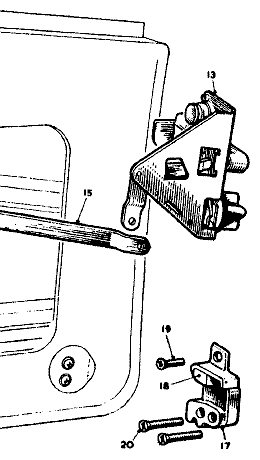The MGA With An Attitude
DOOR LATCHES And STRIKERS, MGA Coupe - CP-113LS
On 25 June 2012, Richard Atkinson in Surrey, England wrote:
"On my Mk II Coupe, the driverís door closes fine but there is some lateral play in the catch mechanism in the open/close direction. A small amount of lateral pressure will move it outwards (and back) about 5mm. The door will not open under more pressure, so no chance of it flying open on a fast left turn. I would like to understand how the mechanism works so that I can either adjust the catch correctly or work out which part is worn so I can buy a replacement".

First be sure the door seal (weather strip) is in place. If the door seal is missing there would be a substantial gap between the door and the mating body flange that might allow the door to move inward too far. There should also be a single rubber snubber along the outboard flange of the shutface plate (shut pillar facing panel). This "bumper" fits between the edge of the shutface plate and the rear most flange of the door outer shell. If the snubber is missing, this also could allow the door to move inward too far. If the door seal and snubber are in place, and the door will still move in/out when latched then the latch is out of adjustment.
The latch mechanism in the door (upper part in illustration at right) has an oblong, horizontal solid block below which is a wheel with teeth. The wheel rotates freely (ratchet action) in the clockwise direction but not in the anti-clockwise direction (right side of car). When the door handle is used, the wheel can rotate freely anti-clockwise for release. You can find much more detail of the in-door latch and locking mechanism in prior pages.
The striker plate assembly (lower part in illustration) has a toothed lower section to engage with the toothed wheel, and an upper section to engage with the solid block on the door latch. There is also a spring loaded block at the top that will move in the inboard direction when pushed. This is an anti-rattle snubber that removes any vertical space in the latch mating parts when the door is closed. The striker plate is attached to the rear door post (B-pillar) with three screws (for the Coupe), two long screws at bottom and one shorter screw at top. These screws go through to a tapping plate inside the B-pillar. That tapping plate is inserted into a slot in the pillar from the inboard side. The slot is covered and obscured by the interior kick panel aft of the door. When the three screws in the striker plate are loosened, the striker can be moved somewhat left to right, and also slightly up/down (along with the hidden tapping plate) to adjust tension and final position for the door when latched.
You can move the hinges in/out to adjust door front edge alignment with outer body panels (front wing and windscreen post). You can move the striker plate in/out to adjust door rear edge alignment with outer body panels (rear wing and roof). The door seal (assuming you have the correct type) should be soft and springy enough to fill the gap between door and body for an effective seal without having to slam the door too hard. Find information about the correct door seals in the Interior Tech section. You do NOT adjust the door to accommodate the seal. You adjust the door for proper outer body panel alignment, and the door seal should compress to fill the gap wherever the door happens to be positioned. If the door will not close far enough for flush fit on the outside, then you likely have an improper aftermarket door seal that is too thick.
When the latch is working properly, there should be two clicks as it closes. The first click (which should easily work with a gentle push) is the safety position, while the second click is the final full latched position with door seal compressed and sealed. You may expect to slam the door gently (not terribly hard) to engage full latch condition. Once fully latched the door should be firmly seated against the door seal and should not wiggle. If you cannot achieve the second (full latched) condition, you need to move the striker plate slightly outboard. If it does make the second (full latched) position, and the door can still wiggle in/out some, then you need to move the striker plate slightly inward to snug it all up. When finished the outer door panel should be flush with the outer wings, and the soft door seal should be nicely sealed with a moderately gentle closing of the door, not requiring a two fisted slam.
|